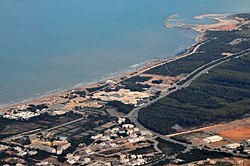Gammarth
Gammarth | |
|---|---|
Town | |
 | |
 Aerial view of the coastline | |
| Country | |
| Governorate | Tunis Governorate |
| Time zone | UTC+1 (CET) |
Gammarth is a seaside resort town on the Mediterranean Sea in the Tunis Governorate of Tunisia, located some 15 to 20 kilometres north of Tunis, adjacent to La Marsa. It is an upmarket resort, known for its expensive hotels and shops. Gammarth began as a small fishing village but following independence from France it blossomed into a resort from the 1950s. Tourism now provides the backbone to the local economy.[1] Gammarth contains many five-star hotels and restaurants and also contains many lavish white villas and coves in the vicinity. Notable villas include Abou Nawas Gammarth and Les Dunes.[2]

Excavations at Gammarth Hill have revealed some catacombs and Talmudic inscriptions.[3][4] These ancient burial chambers are believed to date to Roman times in the 2nd century when nearby Carthage was a thriving Roman city.
Gammarth also contains a notable cinema complex.[5]
Education
Center Sidi Bou Said for Languages (Centre Sidi Bou Said de Langues et d'Informatique) is a language school next to the Sidi Bou Said TGM station which specializes in Arabic, with classes in Modern Standard Arabic (MSA), classical Arabic, Tunisian Arabic and the various dialects of North Africa, the Gulf and the Levant.
See also
References
- ^ Tunisia. Eyewitness Guides. 2008. p. 94.
{{cite book}}: Italic or bold markup not allowed in:|publisher=(help) - ^ Ham, Anthony; Hole, Abigail (2004). Tunisia. Lonely Planet. p. 92. ISBN 978-1-74104-189-7.
{{cite book}}: CS1 maint: multiple names: authors list (link) - ^ Stern, Karen B. (2008). Inscribing devotion and death: archaeological evidence for Jewish populations of North Africa. Volume 161 of Religions in the Graeco-Roman world, BRILL. p. 297. ISBN 978-90-04-16370-6.
- ^ Goodenough, Erwin Ramsdell (1968). Jewish Symbols in the Greco-Roman Period: Illustrations. Pantheon Books.
- ^ Pommier, Pierre (1974). Cinéma et développement en Afrique noire francophone, Volume 3. Bibliothèque, Bordeaux Université, Pedone. p. 152.
